Fogo, Cape Verde
| Native name: <span class="nickname" ">Dja r’ Fogu Nickname: Ilha do vulcão (island of the volcano) | |
|---|---|
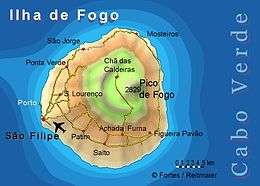 | |
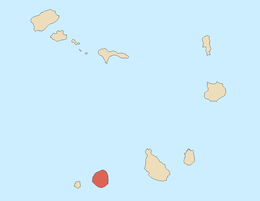 | |
| Geography | |
| Location | Atlantic Ocean |
| Coordinates | 14°57′00″N 24°20′33″W / 14.9500°N 24.3425°WCoordinates: 14°57′00″N 24°20′33″W / 14.9500°N 24.3425°W |
| Area | 476 km2 (184 sq mi) |
| Highest elevation | 2,829 m (9,281 ft) |
| Highest point | Pico do Fogo |
| Administration | |
|
Cape Verde | |
| Concelhos (Municipalities) | Mosteiros, Santa Catarina do Fogo, São Filipe |
| Largest settlement | São Filipe (pop. Sao Filipe) |
| Demographics | |
| Population | 37,200 |

Fogo (Portuguese for "fire") is the most prominent island of the Sotavento group of Cape Verde: it rises to nearly 3,000 metres (10,000 feet) above sea level at its summit, Pico do Fogo.
History
The prehistory of the island had a very large eruption around 73,000 years ago that collapsed the eastern side into the ocean and produced a 170 meter high megatsunami that struck Santiago Island.[1]
Fogo was first sighted in 1456 by Vicente Dias along with Alvise Cadamosto and Antoniotto Usodimare, Fogo was fully discovered in 1460 by a Genovese captain António Noli on behalf of Henry the Navigator and the Portuguese Crown, and was first called São Filipe, meaning Saint Philip in Portuguese. It gained its current fiery name before the 1680 eruption, since a madrigal "The Andalusian Merchant" by Thomas Weelkes, who died in 1623, sings "how strangely Fogo burns, amidst an ocean full of flying fishes".[2]
There are now two cities in the island: São Filipe and Mosteiros.
The Portuguese settled the island in 1500. Emigration started in 1850, mainly to North America. The 1910 civil revolution in Portugal drew aristocracy and large land-owners back to Portugal and left civilians behind. A small museum on Fogo explains many of these connections.
Volcanic eruptions have occurred in 1680, 1785, 1799, 1847, 1852, 1857, 1951, 1995, and 2014.
Geography
One of the southernmost islands in Cape Verde, Fogo is located between the islands of Santiago and Brava. Practically the whole island is a stratovolcano that has been periodically active: it last erupted in 2014. The largest volcanic feature is a nine-kilometre-wide caldera, which has walls one kilometre high. The caldera has a breach in its eastern rim, and in the centre a resurgent dome with an ash cone that forms the highest point of the island: its summit is about one hundred metres higher than the surrounding caldera wall. Lava from the volcano has reached the eastern coast of the island within historical times.
Two small villages, Portela and Bangaeira, exist in the floor of the caldera (Chã das Caldeiras); the residents were evacuated during eruptions.
The island's main city is São Filipe, near which is an airport. Fogo is largely an agricultural island. It has fertile land in the south-west with a slope of about ten to fifteen degrees. The north and the east are steeper. The island rises abruptly from the ocean, which can be as deep as 5,300 metres at a distance of five kilometres from the shoreline. The exception is to the west, where the island is connected to another seamount; further west in Brava.
The steep slopes in the north-eastern part are green and grassy all year round. The rest of the mountain is dry and barren, its dry creeks and streams are dry washes.
São Filipe's buildings use classic Portuguese colonial architecture. Mosteiros in the north-east is the island's second most important town.
A violent eruption took place in 1680, forming a new cone that was visible over hundreds of kilometres but lasted only for a few years. It was during this eruption that the island earned its name.
Flora
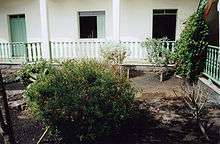

There are various endemic plants on Fogo:[3]
- Cravo-brabo (Erysimum caboverdiana)
- Língua-de-vaca (Echium vulcanorum)
- Losna (Artemisia gorgonum), a medicinal plant with a bitter taste.
- Tortolho (Euphorbia tuckeyana).
Climate
Being one stratovolcano and extremely mountainous, this island has quite a diverse climate and many various microclimates. Along the coast Fogo has a moderate dry tropical climate according to the Köppen–Geiger climate classification system; higher on the slopes (~ 800 metres A.S.L.) it has a semiarid mild tropical climate (Köppen–Geiger Bsh_ with very balanced temperatures year round; above 1,000 metres it has a cool highland subtropical steppe climate (Köppen–Geiger BskL). The average annual temperature on the coast is about 23-25 °C, decreasing to some 12-14 °C on the highest ground.
There can be remarkably cool weather in the interior, with the warmer wet season starting in July and ending in November, with the colder dry season starting in December and ending in May. Drought, the major climate risk of Cape Verdean islands, is much less pronounced on Fogo, due to the mountain's ability to gain moisture from clouds. During the mid-nineteenth century, Fogo suffered from severe droughts. Death from starvation was common in the population as of 1832.[4]
-
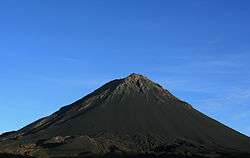
Main ash cone of Pico do Fogo,
called Pico Grande -

3-D image of the island of Fogo from NNE
-

Natural colour satellite image of Fogo
-
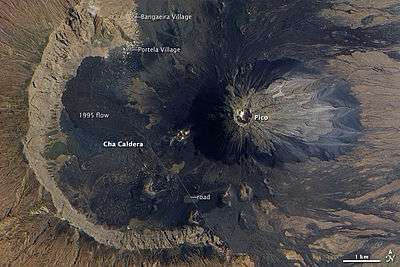
Chã das Caldeiras and main ash cone, Fogo. NASA satellite image, 2009
-

Aerial shot taken from an Airbus cockpit
-
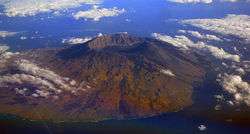
Aerial shot taken from an Airbus cockpit
| Climate data for Bangaeira, centre of the island, 1550-1650 metres ASL | |||||||||||||
|---|---|---|---|---|---|---|---|---|---|---|---|---|---|
| Month | Jan | Feb | Mar | Apr | May | Jun | Jul | Aug | Sep | Oct | Nov | Dec | Year |
| Average high °C (°F) | 14.8 (58.6) |
14.9 (58.8) |
15.4 (59.7) |
15.9 (60.6) |
16.4 (61.5) |
17.1 (62.8) |
17.7 (63.9) |
18.3 (64.9) |
18.9 (66) |
18.4 (65.1) |
17.4 (63.3) |
15.4 (59.7) |
16.7 (62.1) |
| Daily mean °C (°F) | 11.7 (53.1) |
11.5 (52.7) |
11.8 (53.2) |
12.3 (54.1) |
13.1 (55.6) |
13.7 (56.7) |
14.5 (58.1) |
15.2 (59.4) |
15.6 (60.1) |
15.5 (59.9) |
14.2 (57.6) |
12.7 (54.9) |
13.5 (56.3) |
| Average low °C (°F) | 8.7 (47.7) |
8.2 (46.8) |
8.3 (46.9) |
8.8 (47.8) |
9.8 (49.6) |
10.4 (50.7) |
11.3 (52.3) |
12.2 (54) |
12.3 (54.1) |
12.6 (54.7) |
11.1 (52) |
10.1 (50.2) |
10.3 (50.5) |
| Average rainfall mm (inches) | 11 (0.43) |
6 (0.24) |
3 (0.12) |
0 (0) |
0 (0) |
2 (0.08) |
49 (1.93) |
151 (5.94) |
198 (7.8) |
67 (2.64) |
25 (0.98) |
12 (0.47) |
524 (20.63) |
| Source: Climate-Data.ORG[5] | |||||||||||||
| Climate data for Achada Fuma, centre-south of the island, 850-1050 metres ASL | |||||||||||||
|---|---|---|---|---|---|---|---|---|---|---|---|---|---|
| Month | Jan | Feb | Mar | Apr | May | Jun | Jul | Aug | Sep | Oct | Nov | Dec | Year |
| Average high °C (°F) | 19.9 (67.8) |
20.0 (68) |
20.7 (69.3) |
21.1 (70) |
21.6 (70.9) |
22.2 (72) |
22.8 (73) |
23.2 (73.8) |
23.7 (74.7) |
23.5 (74.3) |
22.7 (72.9) |
20.6 (69.1) |
21.8 (71.2) |
| Daily mean °C (°F) | 16.7 (62.1) |
16.5 (61.7) |
17.1 (62.8) |
17.4 (63.3) |
18.1 (64.6) |
18.7 (65.7) |
19.5 (67.1) |
20.2 (68.4) |
20.6 (69.1) |
20.7 (69.3) |
19.4 (66.9) |
17.8 (64) |
18.6 (65.5) |
| Average low °C (°F) | 13.5 (56.3) |
13.1 (55.6) |
13.5 (56.3) |
13.8 (56.8) |
14.7 (58.5) |
15.3 (59.5) |
16.2 (61.2) |
17.2 (63) |
17.5 (63.5) |
17.9 (64.2) |
16.2 (61.2) |
15.0 (59) |
15.3 (59.5) |
| Average rainfall mm (inches) | 3 (0.12) |
3 (0.12) |
0 (0) |
0 (0) |
0 (0) |
1 (0.04) |
22 (0.87) |
115 (4.53) |
149 (5.87) |
51 (2.01) |
14 (0.55) |
8 (0.31) |
366 (14.42) |
| Source: Climate-Data.ORG[6] | |||||||||||||
| Climate data for São Filipe, far west of the island, 20-180 metres ASL | |||||||||||||
|---|---|---|---|---|---|---|---|---|---|---|---|---|---|
| Month | Jan | Feb | Mar | Apr | May | Jun | Jul | Aug | Sep | Oct | Nov | Dec | Year |
| Average high °C (°F) | 25.6 (78.1) |
25.6 (78.1) |
26.2 (79.2) |
26.7 (80.1) |
27.1 (80.8) |
27.8 (82) |
28.4 (83.1) |
28.7 (83.7) |
29.1 (84.4) |
29.0 (84.2) |
28.6 (83.5) |
26.4 (79.5) |
27.4 (81.3) |
| Daily mean °C (°F) | 22.3 (72.1) |
22.1 (71.8) |
22.6 (72.7) |
23.0 (73.4) |
23.7 (74.7) |
24.3 (75.7) |
25.1 (77.2) |
25.7 (78.3) |
26.2 (79.2) |
26.3 (79.3) |
25.2 (77.4) |
23.5 (74.3) |
24.2 (75.6) |
| Average low °C (°F) | 19.1 (66.4) |
18.7 (65.7) |
19.0 (66.2) |
19.4 (66.9) |
20.3 (68.5) |
20.8 (69.4) |
21.8 (71.2) |
22.8 (73) |
23.3 (73.9) |
23.7 (74.7) |
21.9 (71.4) |
20.6 (69.1) |
21.0 (69.8) |
| Average rainfall mm (inches) | 3 (0.12) |
2 (0.08) |
0 (0) |
0 (0) |
0 (0) |
0 (0) |
14 (0.55) |
81 (3.19) |
121 (4.76) |
35 (1.38) |
11 (0.43) |
5 (0.2) |
272 (10.71) |
| Source: Climate-Data.ORG[7] | |||||||||||||
Demographics
As of 1832, Fogo had an estimated human population of 10,000.[4] The official language of Fogo is Portuguese; yet mostly Fogo Creole is spoken. According to the 2013 national demographic census, Fogo was the fourth most populous island in the Cape Verde archipelago.
Economy
The economy of the island is based on agriculture and fishing, with coffee and wine among the main products. In the 1830s, Fogo's wine was described as being "very superior." [4] Due to its volcanic soil Fogo's coffee also has a good reputation. The island has experienced a substantial diaspora. Many households live off remittances from emigrants in the U.S. and in European countries (Portugal, France, the Netherlands, Italy). Fogo fosters strong connections to Rhode Island and to Massachusetts (U.S.), where many people with Cape Verdean origin live.
Tourism is steadily becoming popular. The volcano (allowed only accompanied by a local guide) is the island's major attraction but many visitors also come to see relatives. The historic city of São Filipe and Chã das Caldeiras in the volcanic crater receive the bulk of visitors. No great tourism facilities exist, but there are small hotels and bed-and-breakfasts and local guides offer hiking tours (e.g. Creole Guide with some proposed hiking tours and impressions)..
Administrative divisions
The island is divided in three municipalities, which are subdivided into civil parishes:
Sporting teams
- ABC de Patim
- Académica
- Achda Fluminense
- BeiraMar
- Botafogo, São Filipe
- Cutelinho FC
- Desportivo de Cova Figueira
- Juventude
- Lapinha FC
- Luz Verde
- Nó Pintcha dos Mosteiros
- Spartak
- União de São Lourenço
- Vulcânicos, São Filipe
References
- ↑ Island Boulders Reveal Ancient Megatsunami, Nature, Retrieved 2015-10-06
- ↑ madrigal text.
- ↑ Reitmeier, Pitt: Cabo Verde, p.385. Bielefeld 2009.
- 1 2 3 Roberts, Edmund (1837). Embassy to the Eastern Courts of Cochin-China, Siam, and Muscat. New York: Harper & Brothers. pp. 17–18.
- ↑ https://web.archive.org/web/20140106040657/http://en.climate-data.org/location/492351/. Archived from the original on 6 January 2014. Retrieved 5 January 2014. Missing or empty
|title=(help) - ↑ http://en.climate-data.org/location/492475/. Retrieved 5 January 2014. Missing or empty
|title=(help) - ↑ http://en.climate-data.org/location/3105/. Retrieved 5 January 2014. Missing or empty
|title=(help)
External links
| Wikimedia Commons has media related to Fogo (Cape Verde). |
- Informations and impressions from Fogo
- Caboverde.com
- University of Massachusetts – information and images from Fogo